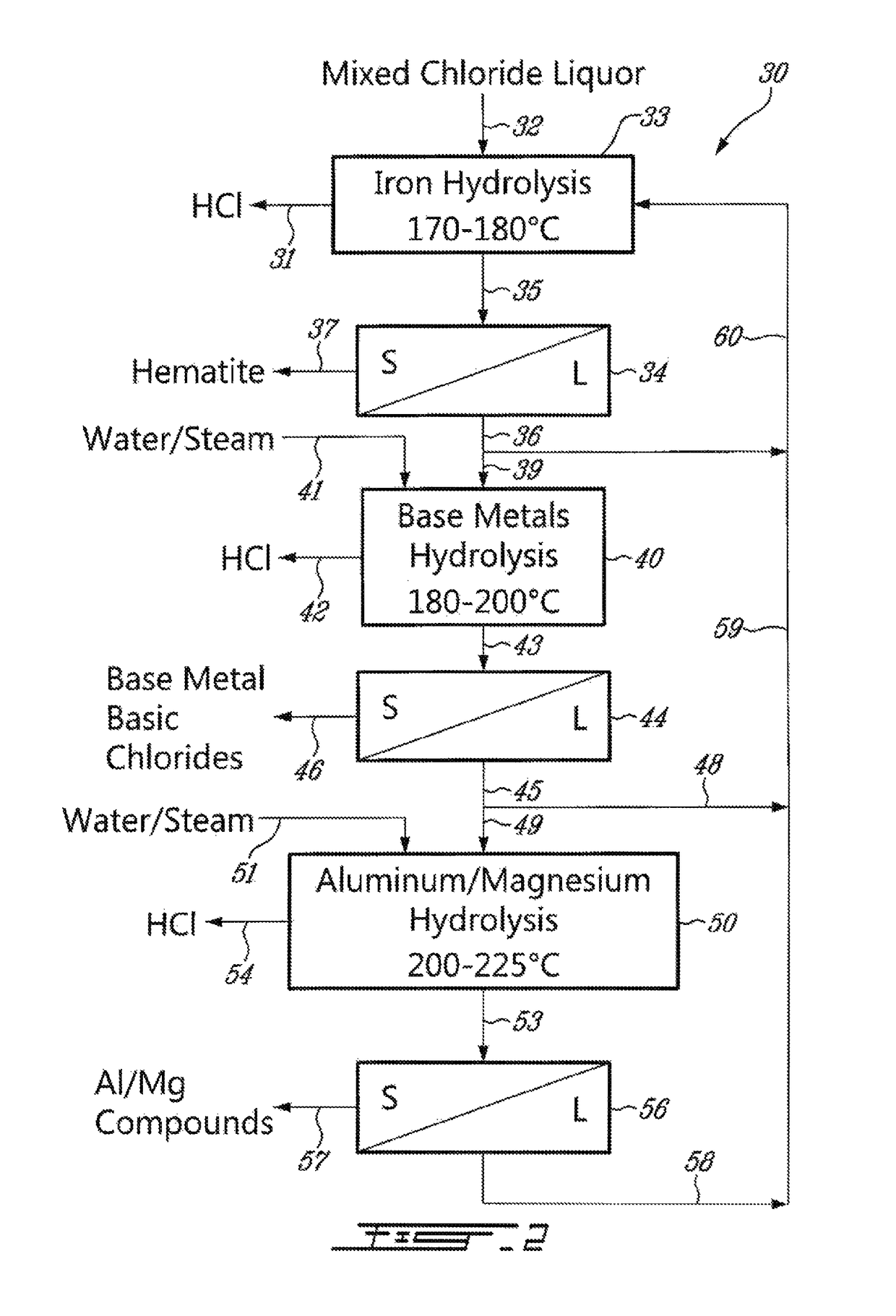Process for the recovery of metals and hydrochloric acid
a hydrochloric acid and metal technology, applied in the field of hydrochloric acid recovery processes, can solve the problems of iron being considered a major problem, unable to exceed the azeotropic concentration of hydrochloric acid, and the strength of hydrochloric acid recovered from this process is limited to 18%, so as to promote hydrolysis and precipitation
- Summary
- Abstract
- Description
- Claims
- Application Information
AI Technical Summary
Benefits of technology
Problems solved by technology
Method used
Image
Examples
example 1
[0078]A series of boiling point tests was carried out for single and mixed chloride salt solutions with the objective of determining the point at which these solutions would freeze, since the freezing aspect is a severe drawback in the processes of Kovacs and SMS Siemag. The solutions were heated up to 225° C., or to the point where significant freezing took place. The following table shows the results of these tests.
[0079]
TABLE 1Boiling Tests on Various Chloride SaltsTestRegimeComments1ZnCl2 aloneLiquid at 225° C.2MgCl2 aloneHydrolyzes beyond 192° C. Solid at 220° C.3FeCl3 aloneSignificant solids at 188° C.; black residue.Solid at 200° C.4FeCl3 / MgCl2 / Slope change around 140° C. A littleZnCl2hydrolysis. Final solution had darkbrown / black / purple residue. Remainedliquid.5FeCl3 / FeCl2At 201° C., significant hydrolysis, 11N (34%)HCl, remained liquid.6CaCl2 aloneBath froze at 175° C.730-70% baseNo significant HCl produced in condensatemetals inuntil 223° C. Remained liquidZnCl2850-50% bas...
example 2
[0083]The solution from test #7 in Table 1, comprising 70% zinc chloride, and 30% (copper chloride plus nickel chloride plus cobalt chloride in the ratio of 10:10:1 on a molar basis) was cooled to 180° C., and water injected. Pale blue crystals were obtained, analysing 50.6% Cu, 0.7% Ni and 0.06% Co. Zinc was not detected. This analysis is equivalent to the basic chloride Cu(OH)2.Cu(OH)Cl.3H2O, and also demonstrates that an effective separation of copper from nickel and cobalt can be achieved from the zinc chloride matrix solution.
example 3
[0084]A solution of 400 g / L aluminum chloride was injected into zinc chloride at 200° C. HCl of concentration 180 g / L was distilled off. At the end of the test, after 500 mL of feed solution had been injected into 1 L of zinc chloride, 96.7% of the Al fed reported to the solid phase, which analysed 41.6% Al and 0.4% Zn. XRD analysis of the precipitate showed it to be predominantly a pseudo-boehmite.
PUM
| Property | Measurement | Unit |
|---|---|---|
| temperature | aaaaa | aaaaa |
| temperatures | aaaaa | aaaaa |
| temperature | aaaaa | aaaaa |
Abstract
Description
Claims
Application Information
 Login to View More
Login to View More - R&D
- Intellectual Property
- Life Sciences
- Materials
- Tech Scout
- Unparalleled Data Quality
- Higher Quality Content
- 60% Fewer Hallucinations
Browse by: Latest US Patents, China's latest patents, Technical Efficacy Thesaurus, Application Domain, Technology Topic, Popular Technical Reports.
© 2025 PatSnap. All rights reserved.Legal|Privacy policy|Modern Slavery Act Transparency Statement|Sitemap|About US| Contact US: help@patsnap.com



